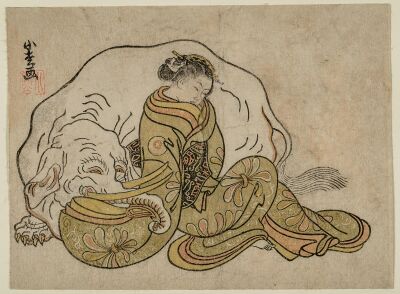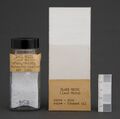Difference between revisions of "Category:Lead white: Ukiyo-e colorant"
| (5 intermediate revisions by 2 users not shown) | |||
| Line 1: | Line 1: | ||
| − | [[File:SC347536.jpg|right| | + | [[File:SC347536.jpg|right|400px|link=Komatsuken, Young Woman as the Bodhisattva Fugen, 11.30136|Young Woman as the Bodhisattva Fugen by Komatsuken]] |
| − | <font size="3">'''[[Lead white]]'''</font> 鉛白(''enpaku''): A white pigment composed of [[lead carbonate, basic|basic lead carbonate]]. Lead white has been prepared synthetically from Classical antiquity by exposing metallic [[lead]] to [[vinegar]] ([[acetic acid]]) vapour. Lead white and [[:Category:Red lead: Ukiyo-e colorant|red lead]] can discolor and darken when exposed to [[Hydrogen sulfide|hydrogen sulfide]]. | + | <font size="3">'''[[Lead white]]'''</font> 鉛白 (''enpaku''): A white pigment composed of [[lead carbonate, basic|basic lead carbonate]]. Lead white has been prepared synthetically from Classical antiquity by exposing metallic [[Lead|lead]] to [[Vinegar|vinegar]] ([[Acetic acid|acetic acid]]) vapour. Lead white and [[:Category:Red lead: Ukiyo-e colorant|red lead]] can discolor and darken when exposed to [[Hydrogen sulfide|hydrogen sulfide]]. |
On a print the color white is usually unprinted paper, however, sometimes lead white was used to set apart fields of white from the paper's natural tone. More frequently, it has been found mixed with other colorants, in order to lighten a color or lend opacity. Most frequently, it appears to have been mixed with red lead to create a light pink color, often seen in wooden architectural elements. Sometimes lead white paint was spattered across the surface of a complete print in order to approximate the appearance of snow or sea spray. Darkening of lead white has been observed in areas where it was printed alone and in mixtures. It is often this discoloration or darkening that leads to its preliminary identification of its presence. | On a print the color white is usually unprinted paper, however, sometimes lead white was used to set apart fields of white from the paper's natural tone. More frequently, it has been found mixed with other colorants, in order to lighten a color or lend opacity. Most frequently, it appears to have been mixed with red lead to create a light pink color, often seen in wooden architectural elements. Sometimes lead white paint was spattered across the surface of a complete print in order to approximate the appearance of snow or sea spray. Darkening of lead white has been observed in areas where it was printed alone and in mixtures. It is often this discoloration or darkening that leads to its preliminary identification of its presence. | ||
'''For additional information see:''' [[Lead white]] | '''For additional information see:''' [[Lead white]] | ||
| + | <br> | ||
<br> | <br> | ||
| Line 45: | Line 46: | ||
== Analysis == | == Analysis == | ||
X-ray fluorescence analysis (XRF) is used to detect lead (Pb), which in a white area, is an indication for the presence of lead white (2PbCO<sub>3</sub>·Pb(OH)<sub>2</sub>). | X-ray fluorescence analysis (XRF) is used to detect lead (Pb), which in a white area, is an indication for the presence of lead white (2PbCO<sub>3</sub>·Pb(OH)<sub>2</sub>). | ||
| − | |||
| − | |||
<gallery mode="packed" heights="200px" style="text-align:left"> | <gallery mode="packed" heights="200px" style="text-align:left"> | ||
| − | + | CHSOS XRF of Lead white.jpg|<center>XRF spectrum of lead white</center> | |
</gallery> | </gallery> | ||
| Line 56: | Line 55: | ||
File:4_White_lead_200X.jpg|Lead white at 200x | File:4_White_lead_200X.jpg|Lead white at 200x | ||
File:4_White_lead_200X_pol.jpg|Lead white at 200x, polarized light | File:4_White_lead_200X_pol.jpg|Lead white at 200x, polarized light | ||
| − | 20464186.jpg|Lead white (audio), <small>by Harvard Art Museums</small>|https://harvardartmuseums.org/tour/660/slide/11147 | + | File:NMAH-AHB2017q005530.jpg|Lead white, <small>by National Museum of American History</small>|link=https://americanhistory.si.edu/collections/nmah_1411976 |
| + | 20464186.jpg|Lead white (audio), <small>by Harvard Art Museums</small>|link=https://harvardartmuseums.org/tour/660/slide/11147 | ||
</gallery> | </gallery> | ||
==List of Prints == | ==List of Prints == | ||
Below is a list of prints where lead white was detected. | Below is a list of prints where lead white was detected. | ||
Latest revision as of 21:29, 12 April 2024
Lead white 鉛白 (enpaku): A white pigment composed of basic lead carbonate. Lead white has been prepared synthetically from Classical antiquity by exposing metallic Lead to Vinegar (Acetic acid) vapour. Lead white and red lead can discolor and darken when exposed to Hydrogen sulfide.
On a print the color white is usually unprinted paper, however, sometimes lead white was used to set apart fields of white from the paper's natural tone. More frequently, it has been found mixed with other colorants, in order to lighten a color or lend opacity. Most frequently, it appears to have been mixed with red lead to create a light pink color, often seen in wooden architectural elements. Sometimes lead white paint was spattered across the surface of a complete print in order to approximate the appearance of snow or sea spray. Darkening of lead white has been observed in areas where it was printed alone and in mixtures. It is often this discoloration or darkening that leads to its preliminary identification of its presence.
For additional information see: Lead white
Examples of Lead white in Ukiyo-e Prints

|

|

|

|

|
Analysis
X-ray fluorescence analysis (XRF) is used to detect lead (Pb), which in a white area, is an indication for the presence of lead white (2PbCO3·Pb(OH)2).
Images of Lead white
List of Prints
Below is a list of prints where lead white was detected.
Pages in category "Lead white: Ukiyo-e colorant"
The following 17 pages are in this category, out of 17 total.
B
H
- Harunobu, A Young Woman in a Summer Shower, 11.19430
- Harunobu, Courtesan and Kamuro Looking at the Face of a Komusô Reflected in a Mirror, 45.833
- Harunobu, Courtesan Reading a Letter by Moonlight Reflected on Snow; Parody of Son Kang, 11.19438
- Harunobu, Ebisu and Ofuji, from the series The Seven Gods of Good Fortune in the Modern World, 34.343
- Harunobu, Nishikigi of the Kanaya Lighting Incense beside a Mosquito Net, 11.16479
- Harunobu, The Sake Cup, sheet 4 of the series Marriage in Brocade Prints, the Carriage of the Virtuous Woman, known as the Marriage series, 11.19475
K
- Komatsuken, Young Man as the Bodhisattva Monju, 11.30137
- Komatsuken, Young Woman as the Bodhisattva Fugen, 11.30136
- Koryusai, Twilight Snow of the Bride, from the series Eight Views of Fashionable Human Relations, 11.19541
- Kuniyoshi, (Actor Ichikawa Ebizô V as) Inuyama Dôsetsu, from the series The Lives of Eight Brave and Loyal Dog Heroes, 11.28841
S
- Shigenobu I, Puppy Playing with a Ball, 21.9257
- Shunkō, Actors Nakamura Nakazô I and Ôtani Hiroji III, 11.2014
- Shunshō, Actor Segawa Kikunojô III as Shirokiya Okoma, from the series Fans of the East, 11.14871
- Shunshō, No. 3, Comparative Poems, from the series Six Types of Waka Poetry as Described in the Preface of the Kokinshû, 11.19295







